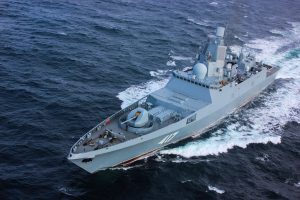
Russia Tests Hypersonic Zircon Missile
Growing geopolitical rivalries will continue to drive the development of hypersonic and other lethal weapons systems.
Russia has reportedly conducted a successful test launch of a hypersonic cruise missile. Russian President Vladimir Putin said earlier this week that the new hypersonic missile, Tsirkon (Zircon) was “part of a new generation of missile systems without equal in the world.” The Russian defense ministry in a statement said that the missile was fired from the Admiral Gorshkov frigate in the White Sea and hit a ground target located on the coast of the Barents Sea, more than 350 kilometers away, with the missile travelling at seven times the speed of sound.
The ministry said that “the tactical and technical characteristics of the Tsirkon missile were confirmed during the tests.” Russia plans to equip its submarines and surface ships with these missiles in the coming years. Even as there are questions about hypersonic missile technology, experts acknowledge that “the combination of speed, maneuverability, and altitude of hypersonic missiles makes them difficult to track and intercept.”
According to one report, given the speed at which they travel, “the air pressure in front of the weapon forms a plasma cloud as it moves, absorbing radio waves and making it practically invisible to active radar systems.” In addition, the reaction time of even the advanced Aegis-class system is too slow to be able to intercept such missiles. Experts estimate that “it would take fewer than a half-dozen of those missiles to sink even the most advanced American aircraft carrier, such as the USS Gerald R. Ford.”
In 2018, Putin announced that Russia was developing a series of hypersonic weapons including the Avangard that “could hit almost any point in the world and evade a U.S.-built missile shield.” In 2019, he threatened to use hypersonic missiles to target the U.S. directly if Washington deployed intermediate-range missiles in Europe, after the Trump administration withdrew from the Intermediate-Range Nuclear Forces (INF) Treaty. Although the U.S. has not yet deployed such missiles in Europe, Russia continues to worry about possible deployments in the future. The U.S. claims that it withdrew from the INF treaty because of Russian cheating.
Putin has boasted of developing many weapon systems, including the Sarmat intercontinental ballistic missiles and Burevestnik cruise missile, that could evade U.S. missile defense systems. The Zircon missile itself has been tested many times and in October 2020, commenting on one of those tests, Putin claimed that it is a “great event not just in the life of our armed forces but for all of Russia.”
Some of Russia’s hypersonic missiles are already claimed to be deployed with its armed forces. According to Russian media reports, the government has “deployed two interceptor jets capable of carrying the hyped Kinzhal hypersonic missile for war games in Syria.” Russia’s defense ministry is quoted in the same report as saying that “a pair of MiG-31K aircraft with the ability to use the latest hypersonic missiles from the Kinzhal complex flew from Russian airfields to the Russian airbase Khmeimim in Syria for exercises.”
Russia is not alone in these efforts. China has been making consistent efforts at developing hypersonic weapons. In 2019, at the military parade on the occasion of the 70th anniversary of the founding of the People’s Republic of China, China showcased the DF-17 missile for the first time. Even though the U.S. has known about the DF-17 prototype for close to a decade, Mike Griffin, the U.S. undersecretary for research and engineering at the Department of Defense, in 2018 revealed that China had done “20 times as many hypersonic weapons tests as has the United States over the last decade.” Like Russia, China’s pursuit of hypersonic missiles appears to have been spurred by U.S. missile defense developments, which could potentially neutralize the traditional ballistic missiles that Russia and China possess.
Reacting to Russia’s latest test, NATO in a statement said that it “create[s] a greater risk of escalation and miscalculation.” It added that “Russia’s new hypersonic missiles are highly destabilizing and pose significant risks to security and stability across the Euro-Atlantic area.” The statement also said that the NATO allies remain “committed to respond in measured way to Russia’s growing array of conventional and nuclear-capable missiles,” but clarified that it will not undertake efforts to “mirror what Russia does, but we will maintain credible deterrence and defense, to protect our nations.”
Growing geopolitical rivalries will continue to drive the development of hypersonic and other lethal weapon systems. With the U.S., Russia, and China all pursuing these technologies, it has already given way to a spiraling arms race. Countries like India and Australia have had to respond as well, albeit at different levels.
Authors

Contributing Author
Rajeswari Pillai Rajagopalan
Dr. Rajeswari (Raji) Pillai Rajagopalan is the Director of the Centre for Security, Strategy & Technology (CSST) at the Observer Research Foundation, New Delhi.
No comments:
Post a Comment